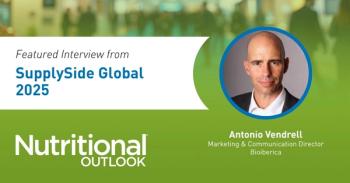
Gencor opens market access to its PEA anti-inflammatory and joint health ingredient at SupplySide West
Until recently, the company had given first right of use to supplement retailer GNC, but the ingredient is now open to the rest of the market.
Palmitoylethanolamide (PEA) is an anti-inflammatory ingredient that was first identified in the 1950s and that has since been used globally in dietary supplement and therapeutic products. U.S. ingredient supplier Gencor (Irvine, CA) promoted its Levagen PEA ingredient at SupplySide West. The company is marketing its PEA ingredient as a joint-health ingredient due to its ability to help manage joint discomfort and support a healthy anti-inflammatory response. Until recently, the company had given first right of use to supplement retailer GNC, but the ingredient is now open to the rest of the market. “The product has been in the U.S. market for more than two years, but we launched it officially at SupplySide West after the protection period,” said Gencor’s managing director R.V. Venkatesh at the show.
Venkatesh explained how PEA works in the body. “It’s an endogenous fatty acid amide produced by the body in response to stressors, pain, and inflammation,” he said. “So it acts as a very good pain reliever for multiple types of pain and inflammation. It’s the body’s own anti-inflammatory and pain-control mechanism as a first responder.”
Not only that, he said, but it is produced throughout the body. “The uniqueness of PEA is that it’s an autacoid,” he said. “Autacoids are produced and used up locally in every tissue; it’s not just produced in one particular organ.” As a result, it’s produced where there is inflammation and pain in the body, he said.
He added that the ingredient is fast-acting (starts working within 15 minutes), and that its half-life is eight hours in the body; however, PEA’s effects are even longer lasting than that, he said. “It prevents the output of inflammatory cytokines and interleukins into your system, and because of this, the effects last longer because it acts on the cause, not on the symptoms,” he explained. “The half-life is eight hours in the body, but the effect you get happens throughout the day because it shuts off the source of the inflammation and the source of the pain.”
PEA is sold in other markets as a supplement ingredient, such as in Europe and Canada, he said, and is the subject of 29 existing published studies for a range of pain types. In the U.S., he said, “as per the DSHEA”-the Dietary Supplement Health and Education Act-“it qualifies as a dietary supplement because it’s present in soy, egg yolk, peanuts. It’s been part of the food system for ages.”
Gencor’s PEA ingredient, Levagen, targets joint health. Venkatesh said the company has conducted studies showing the benefits of a 600-mg dose of Levagen, and even benefits from a low, 300-mg dose. He said that this double-blind, randomized, placebo-controlled study, which was conducted in 120 patients, was completed three months ago and is now under peer review. He said he hopes the study will be published in a few months.
“We achieved significant reduction on the WOMAC scale,” showing relief in pain and stiffness and enhanced function, he said. Not only that, but the company found that there were anti-anxiety benefits “because pain and anxiety are interlinked,” he said, as well as some sleep benefits. The company is now designing a sleep study, he said, based on early benefits researchers saw.
Introducing Levagen+
At SupplySide West, Gencor also rolled out a water-dispersible version of Levagen, called Levagen+, which offers enhanced dispersibility and bioavailability thanks to dispersion technology called LipiSperse from Australian firm Pharmako Biotechnologies (Cromer, Australia). At SupplySide West, Pharmako’s director, Eric Meppem, explained how the company’s technology enhances ingredient dispersibility of lipophilic ingredients like PEA, curcumin, or resveratrol, whose particles generally stick together and thus are not well absorbed.
“The dispersion technology is something that is novel and unique in the industry,” he said. “We created it in 2017 in our laboratory in Sydney, Australia. It’s very unique in that instead of trying to solubilize an active, which you often do with lipophilic ingredients because people either want to emulsify or dissolve the active in water or when they’re in the gastrointestinal tract, instead what we do is, because lipophilic particles hate water so much, we control or manipulate that. We stop them from aggregating, from sticking together, by coating them with LipiSperse, which then enables them to disperse in water or stay separate.”
He continued: “There are a few benefits to that. Obviously, the functional benefit is that you have something that can be mixed into water. It also means that we’re increasing the bioavailability because by keeping the particles separate, what we do is we increase the surface area. So by having a large surface area, it means that the body can actually get more of the nutrient, and the absorption is improved.”
Pharmako’s LipiSperse technology was also applied to Gencor’s HydroCurc water-dispersible curcumin ingredient, which the company introduced at this year’s Natural Products Expo West trade show in March. The companies say that a pharmacokinetic study on HydroCurc showed the ingredient to have significantly increased bioavailability compared to standard curcumin. Meppem said Pharmako is conducting a pharmacokinetic study on Levagen+ as well, in order to demonstrate its enhanced bioavailability, and that this study will be submitted for publication, too.
Another benefit of LipiSperse, he points out, is that the technology comprises only 10% excipients; by contrast, he said, other bioavailability platforms may require 70%-80% of excipient, meaning the user actually gets only 20%-30% or less of the active ingredient. All of this boils down to a smaller dosage size with LipiSperse, he said: “So this means we can not only achieve advanced absorption and improved functionality, but it also enables an easy-to-take dose-only one capsule, for instance.”
Combining with Curcumin
In regarding Levagen, Venkatesh said Gencor is now also exploring the clinical benefits of combining Levagen and HydroCurc for exercise recovery. “We had excellent results,” he said. “Levagen worked on a different pathway, and HydroCurc worked on a different pathway. Levagen reduced myoglobin levels, which are related to muscle damage, so it reduced muscle damage and lactic acid formation, because lactic acid produces pain when you exercise. HydroCurc increased IL-10, which is anti-inflammatory. It also reduced and kept stable IL-6, which is pro-inflammatory, so it showed anti-inflammatory effects as well as recovery from muscle soreness and reduced lactic acid. So both can be a fantastic combination for joint care as well as for sports.” Levagen also touts self-affirmed GRAS status.
Newsletter
From ingredient science to consumer trends, get the intel you need to stay competitive in the nutrition space—subscribe now to Nutritional Outlook.





